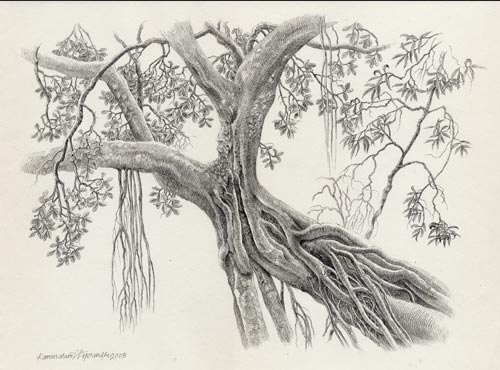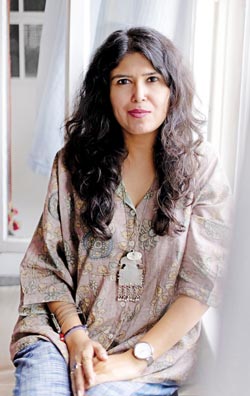Colomboscope: Artists look to regaining lost environmental wisdom

Nuga tree-Lahugala: A sketch by Karunasiri Wijesinghe
The eighth edition of Colomboscope, the interdisciplinary art festival, will take place later this month and will feature the work of over 40 local and international artists in a series of exhibitions, performances, workshops, and concerts at several locations in the city.
Since its very first edition in 2013, the festival has worked with a range of inter-generational artists, writers, musicians, filmmakers, social theorists and scientific researchers to serve as a creative platform to ensure that cultural producers continue generating path-breaking, collaborative and genre-defying approaches in the field.
“It has been a decade since the first edition of Colomboscope was held in 2013. Since then this itinerant festival has inhabited several corners of Colombo. A generation of artists, writers, and thinkers have gone on to realise path-breaking creative visions as part of this journey, and the platform has grown into an autonomous, non-profit initiative,” says Natasha Ginwala, Artistic Director. “This edition will feature artists from across the island, different parts of South Asia and the world. We are excited to welcome several cultural professionals including museum directors and arts patrons.”
This year’s theme, ‘Way of the Forest’, links up various artistic pathways to rekindle knowledge of interdependence, custodianship, and restorative practices across rainforests, mountain cultivations, wilderness, and riverine wetlands and invites de-schooling which involves moving away from the curriculum of plunder, reckless supremacy and extinction and ultimately embracing active listening beyond the human sensorium. This edition’s concept is an intricate study of our eroding ecological histories, of lost environmental wisdom, monstrous developmental agendas, and the ghosts of extraction and has the artists questioning who owns forest lands, who gets displaced, and who is restricted from sites marked for conservation.
‘Way of the Forest’ weaves narratives around how repressed history turns to myth and lore when what was sensuously real becomes illusive. “The curatorial concept reflects on the forest as a multi-species school, a place of origin stories, medicinal ground, an ancient altar, and a sensory communication network that far exceeds human intelligence and lifespan,” elaborates Natasha.

Artistic Director: Natasha Ginwala
The multi-chapter exhibition will feature works from the collections of well-known Sri Lankan artists like Barbara Sansoni, Laki Senanayake, Anoma Wijewardene, and Karunasiri Wijesinghe as well as many co-commissioned artworks from local artists from across the island. Krisushananthan Inkaran’s wood sculptures depict the war-torn forests of the Northern Peninsula, illustrator and artist Ruwangi Amarasinghe envisions the forest as a life source of blessing while also outlining the spread of greed and corruption that sets out to suffocate the woods. Dancer and choreographer Pathum Dharmarathna’s dance film Bhawana is an ode to the artist’s village ecology and childhood memory.
International artists whose work will be displayed during the festival include Indian artist Anupam Roy whose creation of distemper, acrylic and black pigment on tarpaulin co-commissioned by Colomboscope and the Ishara Art Foundation hones in on the mechanisation of rural cultivation and corporate land acquisition, Fernando Garcia-Dory’s ThinkAForest (2023) that showcases a series of drawings, research, pottery, digitally rendered distillation vessels, models of biomorphic architectures, and a sound landscape of interspecies relations within the forest.
The festival will also have art and installations by collectives such as BLAK C.O.R.E, an Australian collective driven by First Nations methodologies, research, and cultural practices. Projects such as one initiated by Voices of Women Media titled ‘Memory, Truth and Justice’ which seeks to preserve, record, and dignify the memories of survivors and families of victims of the armed conflict in Nepal that took place from 1996 to 2006 will also be showcased as well as artwork from artists from the Mithila region who offer a window into understanding the rapid ecological and cultural shifts such as rapid deforestation, labour migration, shifting farming techniques, and loss of biodiversity that have taken place alongside the Nepal-India border.
Other artists and collectives who will have their work exhibited during the festival include Anushka Rustomji, U. Arulraj, Chija Lama, Dumiduni Illangasinghe, Jayatu Chakma, Karachi LaJamia, Kulagu Tu Buvongan, Müge Yılmaz, Nahla al Tabbaa, Otobong Nkanga, Pankaja Withanachchi & Roshan De Selfa, The Initiative for Practices and Visions of Radical Care with Myriam Mihindou, Tawfiq Sediqi and Elena Sorokina, Rakibul Anwar, MTF Rukshana, Sarmila Sooriyakumar with Pirainila Krishnarajah, Shiraz Bayjoo, Pushpakanthan Pakkiyarajah, Spore Initiative with U Yits Ka’an, Colectivo Suumil Móokt’aan, Rafiki Sánchez, and Cecilia Moo, Tamarra Jayasundera, Thava Thajendran, Thujiba Vijayalayan, Sangita Maity, Sanod Maharjan, Saodat Ismailova, Shehan Obeysekera, Soma Surovi Jannat, Subas Tamang, Sunita and Sanjeev Maharjan, Venuri Perera and Eisa Jocson, and Zihan Karim.
The festival will take place from January 19-28, 2024 at SNAFU Project, Goethe-Institut Garden, Public Library Garden, BMICH Kamatha Open Theatre, Ex-Government Servicemen Sports Club, CoCa Symbiosis, SpaceEka, Barefoot, MMCA, Beddagana Wetland Park and the J.D.A. Perera Gallery.
Visit https://www.colomboscope.lk/way-of-the-forest for more information.
Searching for an ideal partner? Find your soul mate on Hitad.lk, Sri Lanka's favourite marriage proposals page. With Hitad.lk matrimonial advertisements you have access to thousands of ads from potential suitors who are looking for someone just like you.


